Exercise for deltoid: Health Benefits, Variations & How to Do?
Exercise for Deltoid muscle is a great way to improve your shoulder functions and makes your shoulder more powerful to do your activity with ease and also many health benefits.
The deltoid muscle plays an important role in shoulder movements, and it is quintessential that you train deltoid muscle with a highly targeted workout regime. The deltoid muscle has 3 heads anterior, medial, and posterior. The anterior delts help move your arm forward. They connect to your clavicle. You use your front deltoids if you reach for an object on a shelf. Lateral deltoids: Side deltoids that help to move your arm out to the side, as well as up and down, The primary action of posterior delts is external rotation, extension, and horizontal abduction,
Strengthening those deltoids will automatically enhance your strength and ability to do a ton of different exercises. Also, strengthening your shoulders helps to get better posture, so we look confident, feel sexier, and prevent injury.
take time and think about how many things you carry from point A to point B in your daily life. Groceries up the stairs, Your backpack to the office. Strong arms are important to perform all activities but if you are sleeping on your shoulders, you are making a big mistake.
Male and females both tend to have developed anterior deltoid muscles by doing everyday activities, like lifting and pressing objects. But most people have pretty weak middle and back deltoids, since we rarely lift objects to the side or behind us in daily life, So, to build fully defined shoulders, you want to include some targeted deltoid exercises in your workout routine. Here are some of the best deltoid exercises to help you get bigger and stronger.
Health benefits of Deltoid exercise:
- Shoulder strength exercises can promote healthy movement patterns and improve posture and muscle function.
- Performing these exercises regularly can help to treat and prevent shoulder injuries and allow you to move with greater ease and strength.
- The deltoid exercise strengthens your shoulders, upper back, and upper arms.
- It helps to improve posture and is beneficial for people who sit or do forward-bending movements often.
- Improve the range of motion and flexibility of your deltoid muscle
- Reduce tension and tightness in your shoulders
- Improve your body posture
- Lower the chance of shoulder injury and sprain
- Boost the athletic performance
Types of Exercise for Deltoid:
Deltoid exercise are mainly of two types:
- Deltoid strengthening exercise
- Deltoid stretching exerccise
Deltoid muscle strengthening exercise:
There are too many variations of Deltoid strengthening exercise you can do at Home and in the gym.
Variations of Deltoid strengthening exercises.
Anterior Deltoid Raise
Benefits: One of the best anterior deltoid exercises, this targets the muscle’s anterior head of the deltoid. This helps to build the strength needed to lift objects in front of you.
How to do it?
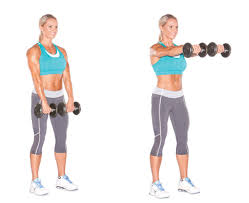
For this exercise, you have to Stand with your feet hip-width apart, grab a dumbbell in both hands with your arms by your sides.
Your arms should be straight, slowly lift the dumbbell directly in front of you to shoulder height with your palms facing each other.
Slowly Lower back down to the initial position and repeat.
Do 10 to 20 repetitions of 2 to 3 sets.
Callahan Press
Benefits: This exercise hits all three heads of the deltoids, a Callahan press helps with full-shoulder development.
How to do it?
For this exercise, you have to stand with feet hip-width apart, grab a dumbbell in both hands.
Raise your arms out to your sides with your elbows flexed up to 90 degrees.
Your upper arms should be in line with your shoulder joint, and your hands should point toward the ceiling. This is the initial position.
Move your forearms in front of you and turn your palms inside toward your face.
Then reverse the movement to return to the initial position.
Press the weights directly above your shoulders, and then reverse the movement to return to the initial position.
That is one repetition.
Do 16 to 20 repetitions of 2 to 3 sets.
Jerk Press exercise
Benefits: The jerk press helps to build strength and power, and you use the deltoids along with your trapezius and triceps.
How to do it?
For this exercise, you have to stand with your feet hip-width apart, grab a pair of dumbbells in front of your shoulders, palms facing each other. This is the initial position.
In one explosive motion, press the weights overhead while jumping right foot forward, and left foot back so you land in high lunge.
Step your front foot back to the initial position, bringing the weights back to shoulder height.
Do 8 to 12 repetitions of 2 to 3 sets.
Hammer Curl to Press
Benefits: Not only does this combination movement work your deltoids, but it also utilizes many other muscles in your upper limb, including your forearms, biceps, and triceps.
How to do it?
For this exercise you have to Stand with your feet hip-width apart, grab a dumbbell in both hands with your arms at your sides, palms facing each other.
Your elbows should be tucked into your sides, curl dumbbells up towards your shoulders without moving your upper arms.
Press the dumbbells above your head until your arms are extended, your palms should be facing each other.
Lower the weights back down to your shoulders, then lower your arms all the way straight down to your sides.
Do 10 to 16 repetitions of 2 to 3 sets.
Bent-Over Lateral Raise (Reverse Fly)
Benefits: Even though the rear deltoids get employed during back exercises, they tend to be one of the least developed muscles on the body because people do not target them specifically enough. This move is one of the best to target your posterior delts. Be sure to maintain strict form to keep them engaged and keep your spine safe.
How to do it?
For this exercise, you have to Stand with your feet hip-width apart, grab a dumbbell in both hands at your sides.
Hinge at your hips, your back should be flat, and allow your arms to hang straight down with your palms facing each other.
With elbows slightly flexed, raise your arms out to the sides until they are parallel with your back. Slowly lower the dumbbells and repeat.
Do 10 to 20 repetitions of 2 to 4 sets.
Sumo Circle Chop
Benefits: This total-body move employs your quadriceps, glutes, all 3 parts of your deltoid muscles, and your obliques.
How to do it?
For this exercise you have to stand with your legs wide, toes turned out 45 to 50 degrees, grab one dumbbell with both hands in front of your chest. This is the initial position.
Push your hips back as you slowly lower into a sumo squat, your back should be straight.
Push through your heels to extend your legs.
Starting on the right, circle the dumbbell around your head, rotating it around and back to the right.
As you bring the dumbbell around to the front, continue the movement and pivot both feet to your right.
Flexed both knees into a lunge and straighten your arms to slowly lower the dumbbell in front of your front knee.
Extend your legs and pivot back to the initial position, move the dumbbell back in front of your chest. Repeat on the left side.
Do 10 to 20 repetitions on both sides for 2 to 3 sets.
Seated EZ Bar Underhand Press
Benefits: This move may seem simple, but you are working the anterior head of your deltoid, your triceps, and your serratus anterior (the muscle under your shoulder blade that covers your ribs), all to build strength in and improve shoulder stability.
How to do it?
Adjust an incline bench so the back is vertical and sit on the seat.
Load an EZ Bar and hold it in the middle with an underhand grip. flexed your arms to bring the bar underneath your chin.
Press the bar directly overhead until your arms are extended.
Slowly bring the barbell back down right below your chin, and repeat.
Do 18 to 20 repetitions of 2 to 3 sets.
Upright Row to Hip Fly
Benefits: This two-part move targets the medial heads of your deltoids, your trapezius, and your biceps, all of which help build pulling strength.
How to do it?
For this exercise you have to Stand with your feet hip-width apart, grab a pair of the dumbbell in front of your thighs, palms facing you.
Your chest should be up and core engaged, lift the dumbbells to your chin in an upright row.
Your elbows should not raise above the shoulder height.
Bring your arms down to your sides, flex your knees, push your hips back, and hinge forward into a flat back.
Let your arms hang straight with your palms facing back.
Your arm should be straight and shoulder blades pulled back, raise the dumbbells behind you.
Lower your arms and repeat.
Do 8 to 12 repetitions of 2 to 3 sets.
Dumbbell Lateral Raise
How to do it?
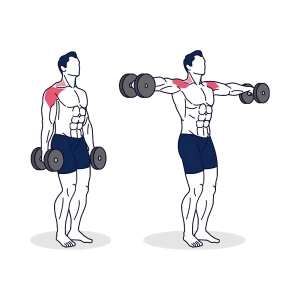
This is a very effective exercise that targets the anterior and the medial deltoid muscles. Additionally, the exercise targets the upper back, trapezius, and core.
For this exercise Stand straight with feet planted shoulder-width apart. grab dumbbells in both hands with a pronated grip.
Slowly raise your arms in an arc to the sides until the dumbbells are in line with the shoulders. Don’t flex your elbows and ensure that the arms are parallel to the floor.
Stop for a moment and return to the starting position.
Do 10 to 15 repetitions of 2 to 3 sets.
Decline Push-Up
How to do it?

The push-up is traditionally known for building the strength of pectoral muscles in your chest. The decline push-up is an advanced variation of the standard push-up that works the anterior deltoids with greater intensity.
For this exercise, you have to Lie on the ground in a prone position with the hands planted around shoulder-width.
Place your feet on an elevated platform such that the body forms an acute angle with the ground.
The elbows should be bent, and the torso should only be centimeters away from the ground.
Elevate the upper limb until the arms are fully straightened and perpendicular to the floor. Hold at that point for 2 seconds then return to the initial position.
Do 10 to 20 repetitions of 2 to 3 sets.
Walking Plank
How to do it?
For this exercise, you have to begin with a high plank position.
Bracing through the core, move your left hand and left foot out six to seven inches.
Bring your right foot and right hand to meet it.
Slowly move left for 15 to 20 seconds, then return to the initial position to complete the set.
Face Pull exercise
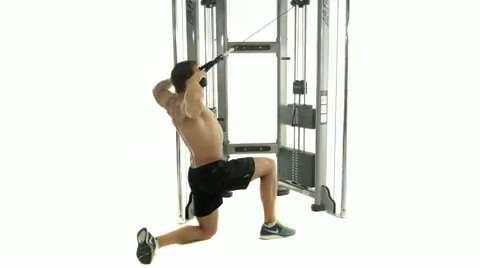
How to do it?
Kneel with your left foot forward in front of a cable machine.
Grab the handles by your palms facing in and pull them toward your face, drawing your hands apart.
Hold at that point for a couple of seconds, then return to starting position.
Do 10 to 20 repetitions of 2 to 3 sets.
Barbell upright row
How to do it?
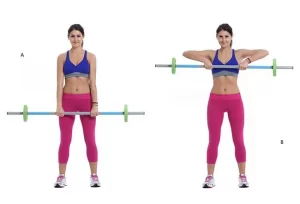
The barbell upright row works the anterior and middle heads of the deltoids.
For this exercise you have to Stand with your shoulder- feet width apart. grab the barbell and allow it to hang in front of you at the length of your arms. Keep Your palms facing your body and your hands in line with the thighs.
Inhale and brace the abdominals. your back should be straight, chest up, and eyes focused forward.
Lift the bar straight up (toward the chin) with a breath out.
Lead with the elbows and keep the barbell close to the body.
Your arms should go no higher than shoulders height; slightly less is okay.
Hold at the top of the lift for 2 to 3 seconds.
Lower the bar as you breathe in, returning it to the initial position.
Do 10 to 15 repetitions of 1 to 2sets.
Side-lying external rotation
How to do it?
The side-lying external rotation focuses on the outer movement that the posterior deltoid performs. It also works on some rotator cuff muscles (infraspinatus and teres minor).
For this exercise, you have to lie on the right side, holding a light dumbbell in your left hand.
Place your left arm on your side with your elbows flexed at 90 degrees. If you have broad shoulders, place a towel roll just between your upper arm and your trunk.
Rotate your arm on your trunk as far as you can without letting your upper arm drift off your body.
Hold for 2–4 seconds, and then slowly lower it back to the initial position. Do 10–15 repetitions for 2 to 3 sets.
Assisted pull-up exercise
How to do it?
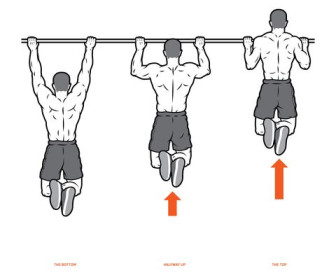
This is a very effective exercise movement, but most people do not have the upper limb strength to perform one without a little help.
This movement works not only on your posterior deltoids but also work on your lattisimus dorsi, trapezius, and biceps.
Adjust the weight deduction on the side of the machine. Choose the correct amount and set. Climb onto the knee pad and push it down until it’s low enough for you to place both knees on.
Keep Your knees up to hip-width apart. Hold the outer handles above you, your palms should be facing away from the center.
Straighten your arms and lower yourself to the initial position. Pull your body up until your chin is level with or above the handles.
Hold the position for a couple of seconds, then lower yourself down with control.
Focus on keeping your shoulder blades contract. They should be pressed back and down.
Start with 8–10 repetitions and work up to 12–15 repetitions.
Deltoid Stretching exercise:
If you are doing regular strengthening, it is also important to stretch deltoid muscle at regular intervals to maintain flexibility of the muscles. Regular strengthening and stretching of deltoid both are equally important.
List of of deltoid stretching exercise
There are some of deltoid stretching exercise list are:
- Anterior deltoid stretch
- Lateral deltoid stretch
- Posterior deltoid stretch
- Dynamic bear hug stretch
- Modified downward dog
How to stretch deltoid?
If you want stretch your tight deltoid muscles, following exercise is the best exercise you can do at home.
Anterior deltoid stretch
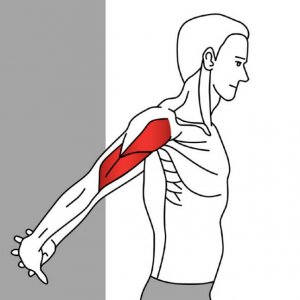
How to do? – Stand straight with feet hip-width apart, your shoulders are relaxed so that your scapulae are tucked downward along with either side of your spine.
Clasp your palms behind your back, then raise them away from the body while your elbows are straight. When you feel stretch stop there and hold that position for 15-30 seconds.
Don’t bend your body at any level during motion, stand upright.
If you have any problem clasping your palms behind then hold a towel between the palms.
Perform this stretch 2-3 times.
The anterior deltoid stretch has some variations:
- Isolation of internal rotation
- Doorway stretching
- Bridge position stretch
Isolation of internal rotation
Isolate internal rotation to target only the anterior deltoids.
How to do? – Take a supine position with your arms extended away from your shoulders. Lift your one hand so that your elbow is at a 90-degree position and your forearm is at a right angle to your body. Slowly down your hand until it is resting at the side of your body. Hold that stretch for a second, then return to begin.
Perform 3-4 sets of 20 repetitions. Do on another arm.
Lower your arm as far as you can reach without pain. Do repetitions as much as you can, then increase over time.
In advance, you can lift weight such as a dumbbell during the stretch.
Doorway stretching
How to do? – Stand straight in a doorway with feet hip-width apart.
Place your right palm on a doorway slightly lower to your shoulder level, the elbow is slightly bent.
Turn your body away from your right arm. When you feel stretched then hold that position for 10-20 seconds. Then do on a left side.
You can use any static object for hold such as a vertical bar, wall.
Bridge position stretch
How to do? – Take a sitting position. Bend your knees and your feet should be flat on a floor.
Your hand is next to the body and your fingers are pointing forward.
Take a breath in and press your feet and hands against the floor while lifting your body from the ground into the bridge position. Your upper body and thighs are parallel to the ground. Straighten your legs one at a time without lower down your hips to do bridge position. Now relax the neck and lower down the head.
Now that position for 30 seconds, then reverse the motion and take starting position.
Beginners start with 5 second holds then gradually increase time.
When you hold a position breathe in by your nose and out by your mouth, and it should be slow and deep.
Lateral deltoid stretch
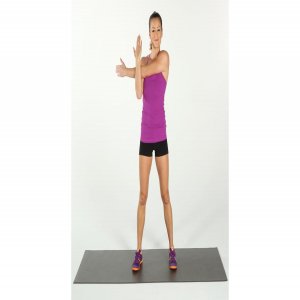
It is also called cross body deltoid stretch.
How to do – Stand straight with your feet hip-width apart. Now position your left hand across your body or horizontal to the body with your elbow is slightly in a bending position.
Grasp at the end of your upper just above your elbow with your right hand.
Now push the left hand towards your body with the right hand.
When you feel stretched, hold that position for 30 seconds. Then do on the right side.
During the motion, your shoulder is in a relaxed position.
Lateral deltoid stretch has some variations:
1) How to do? – Take a standing position with your feelings around hip-width apart, next to a table or bench.
Lean forward, place your left hand on a table for support.
Now slowly swing your right arm forward and backwards like a pendulum, which is hanging on the side of the table.
Don’t move your body while motioning. Your back is straight and your knee is slightly bent. Now repeat the motion side to side then in a circular movement.
Turn around and do it on a left arm.
Do 2 sets of 10 repetitions.
2) How to do? – Stand straight, your back is straight, your feet around hip-width apart.
Place your right arm behind the back with 90-degrees of elbow flexion. Now hold that elbow by the left elbow.
Then pull your right elbow towards your left-back by the left hand.
When you feel stretched, hold that position for 15-30 seconds.
Repeat it on the left hand.
Do 3 sets on each side.
Posterior deltoid stretch
How to do? – Start with crossover stretch. Relax the shoulders, pull them back so that your scapulae fall on either side of the spine.
Reach one horizontally your body and grasp with the other hand at the upper arm.
Slowly start pulling that arm against your chest and opposite side. When you feel stretched stop there.
Hold this position for 30 seconds and repeat on the other side.
Do 4 repetitions on both sides.
Posterior deltoid stretch has some variations:
- Sleeper stretch
- Bent over horizontal abduction stretch
Sleeper stretch

How to do? – It activates supporting muscles. take a side-lying position with your lower arm is 90 degrees bent so that the forearm is at a right angle to your body.
Use the other arm to push your arm downward. If you feel stretch then hold that position for 30 seconds, then give rest for 30 seconds.
Repeat this stretch on another side. Do not bend or press on your wrist during the stretch.
Bent over horizontal abduction stretch
How to do? – Take a prone position at the edge of the bench or bed, so that your one arm hanging out of the bench.
Begin with straight your hanging arm, and gently lift it on your eye level, without bending your arm.
Now slowly lower down to the beginning position.
Do 3 sets with 10 repetitions. now switch to the other arm.
Only lift your arm as much you can without feeling pain. Once you master it then add some weight.
Dynamic bear hug stretch
The dynamic bear hug stretches your anterior and posterior parts of the deltoid as well as your chest.
This is the best movement to perform before a workout.
How to do this stretch – Stand straight with your feet shoulder-width apart.Make sure to engage your core and your posture is straight.
Reach your arm out and wide, at 90 degrees abduction.
When you feel a mild stretch in front of the shoulders and chest then bring the arms across your chest. Try to hug yourself , so that your left arm is on top of your right. You can feel stretching on the back of your shoulder.
In a controlled movement, swing your arm in starting position. Try to reach the end range of motion before your arms goes back to the hugging position. This time your right arm is on top of your left arm.
Do it for 30 seconds, then take a rest. repeat 2 more rounds.
Modified downward dog
The modified downward dog is targeted the chest and anterior deltoids. And it’s the best way to improve posture because it also stretches your low back, glutes, and hamstrings.
Plus, it’s easy to perform at your workplace because it is a comfortable stretch.
How to do this stretch – Stand straight behind a stable desk, chair or table. Place your feet around hip-distance apart.
Now engage the core and stand with a good posture.
Put your hands flat on the desk with your arms are fully extended.
Make sure to straighten up your arms, back and legs during the stretch, only hips are flexing.
Take deep breathing, start walking backwards until your body forms an inclined line. Now tip your upper body forward and your hips backwards. Extend your arms over the head as you go backwards.
When you feel stretch at the front of the shoulders and chest then hold that position.
Hold that for 30 seconds. Release and repeat it 2 times.
Safety and precautions during Deltoid stretch
There are some tips to provide safety during stretching.
- Deltoid stretch may be uncomfortable, especially when you are stiff. try not to stretch at your painful level.
- Don’t bounce. Ballistic stretching is dangerous, so avoid bouncing during your stretches unless suggested by your physical therapist.
- Go gently. Mostly, stretches are slow and gentle, so don’t race to complete a stretch.
- If you have a prior injury, such as an acute or chronic, try stretching after your therapist’s suggestion.
- If you aren’t able to do the stretch perfectly, don’t force yourself to do it.
- If you have any fracture around your shoulder joint then don’t perform the stretch.
When did you not do the Deltoid exercise?
If you are already suffering from shoulder pain then you should avoid painful exercise.
If your doctor advised you to take a rest.
If your arm bone is recently fractured.
If you have back pain then avoid weight lifting exercises.
Avoid too much exercise.
Avoid heavy lifting exercise. Gradually increase the repetation and weight of Dumbells.
If you feel any shoulder pain or discomfort during this exercise.
If you have any pain, sprain or bursitis then don’t perform it.

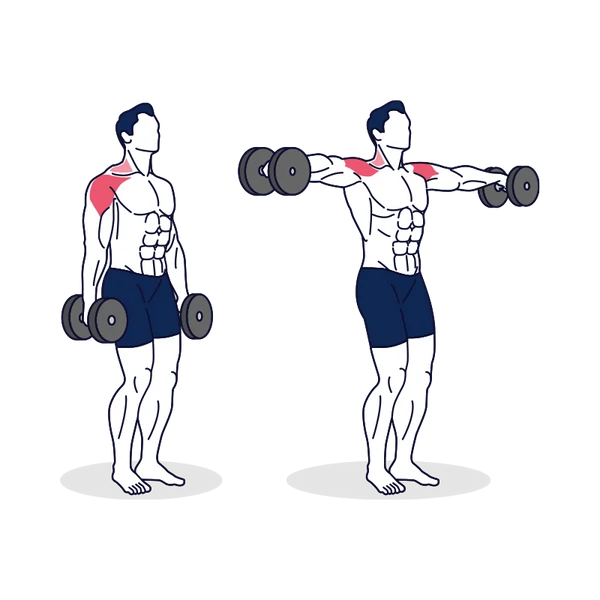
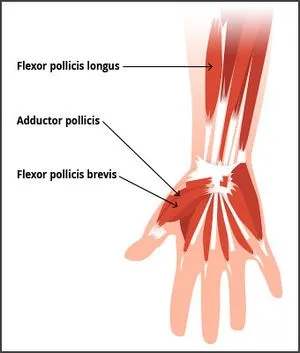
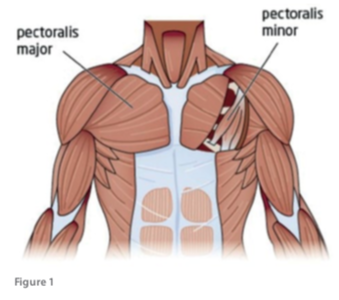

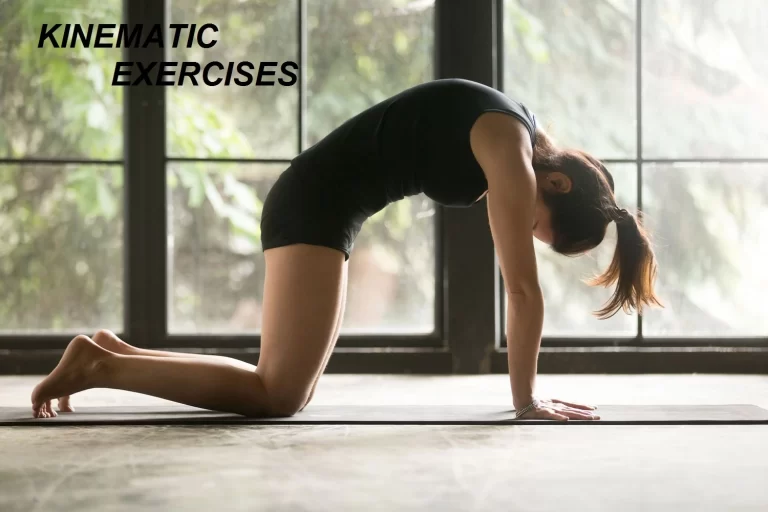
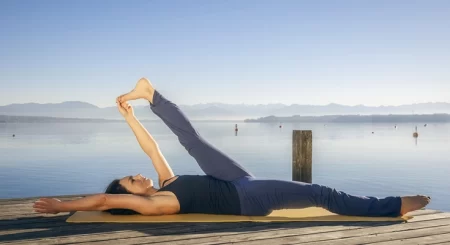

3 Comments